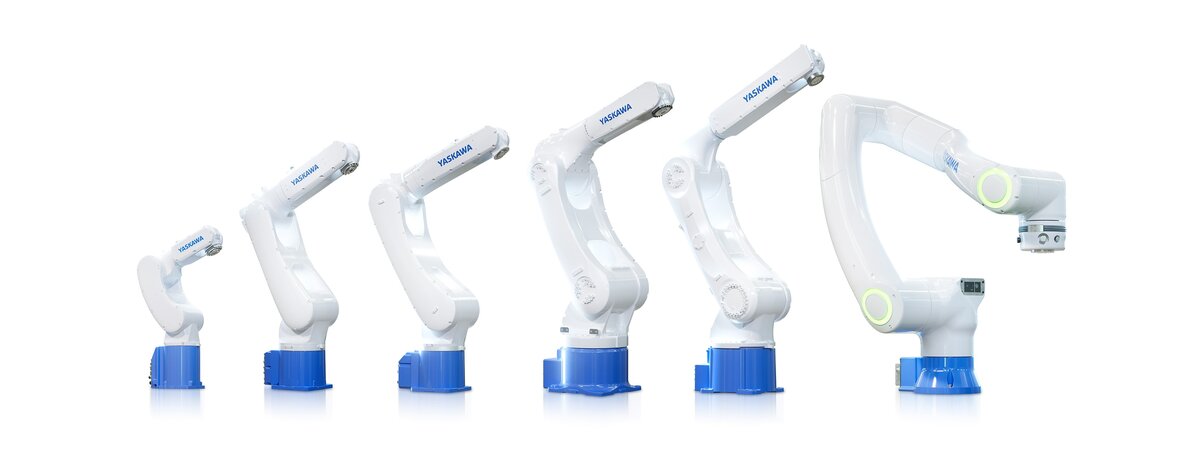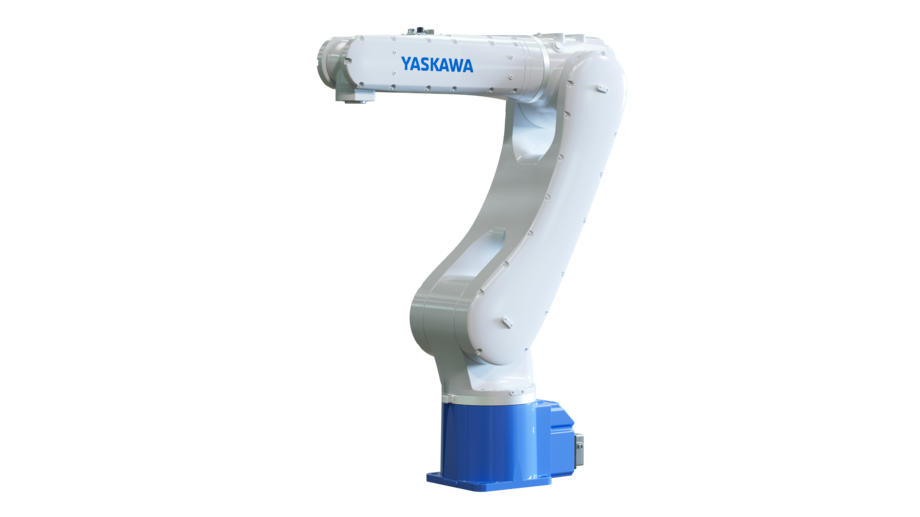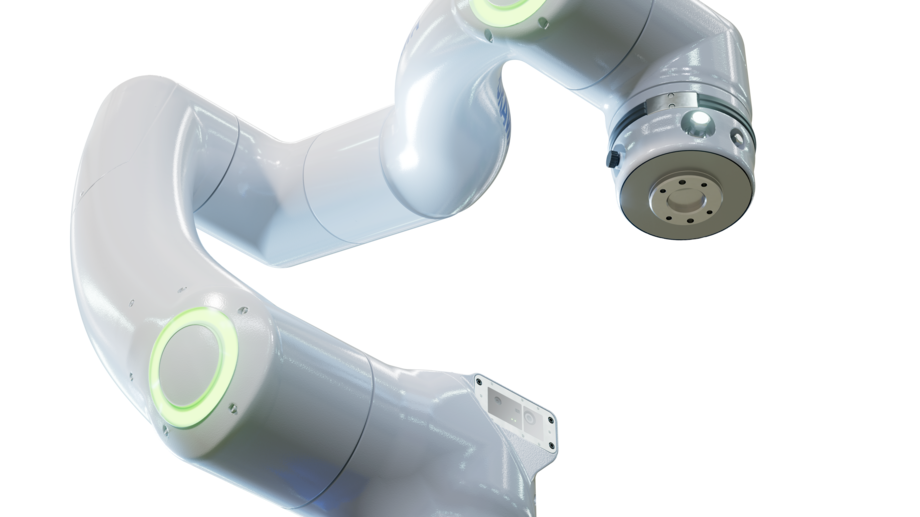Our industry-leading, high-speed industrial robots include high-payload, extended-reach, ultra-maneuverable seven-axis and unique 15-axis dual-arm robots.
MOTOMAN NEXT - A new platform from Yaskawa for intelligent adaptive robotic automation and AI
MOTOMAN NEXT is a new all-in-one technology platform, including robot hardware, software and engineering tools, opening the stage of robotic automation, leveraging Machine Learning and Artificial Intelligence, for more intelligent and adaptive robot solutions. Robot users, software developers and system integrators find a smart and convenient entry to build, deploy and operate intelligent robotic applications which were previously considered difficult or uneconomical to automate. Robots in combination with AI, machine vision and sensor technology are seen as the key to overcome the challenges of demographic change and labour shortages.
MOTOMAN NEXT is a harmonized system including robot and control hardware, software and engineering tools. The RCU (Robot Control Unit) is supplemented by an ACU (Autonomous Control Unit) based on a powerful NVIDIA® Jetson Orin™ NX-Edge device with integrated CPU and GPU. The ACU hosts a Linux operating system supporting modern docker container deployments. Yaskawa adds relevant robot-specific core functionalities by providing pre-installed software services and skills, including automatic collision-free path planning, motion control, access to I/Os, as well as function modules for force sensing and 2D/3D/AI-based image processing (HALCON© Library). A ROS bridge, implemented through the gRPC protocol, connects the Yaskawa Services to ROS2 software modules, which are developed by the agile and innovative ROS robotics community.
All-in-one robot control platform "managed by Yaskawa"
By integrating both robot control worlds (RCU and ACU), MOTOMAN NEXT pioneers to combine programming methods from the classic, signal-based automation world (OT) and the data-based IT world - on one single robot controller platform, eliminating the need to run robotic applications on an additional external PC.
Yaskawa takes over the management of the hardware platform and core software modules (services and skills) and takes over the time-consuming setup and pre-configuration of a Linux PC. The result is an all-in-one solution including approved software modules and core robotics functions which are perfectly tuned to the robot system.
Engineering and Digital Twin
The MOTOMAN NEXT package includes a professional engineering and simulation tool, YNX Robot Simulator, which acts as a digital twin to enable virtual development, testing and optimization of intelligent robotic solutions. Alternatively, experienced software developers can choose the engineering toolchain from NVIDIA® (Isaac Sim™, cumotion), which Yaskawa is one of the world's first industrial robot manufacturers to fully support.
“Code and Produce” vs. “Perceive & Produce”
Conventional industrial robots are programmed upfront for a predictable spectrum of workpieces and defined environments. However, if this spectrum gets inpredictable in regards of variety, batch size or working sequence, flexible robots are required to recognise, understand and react to new situations and workpiece variants, involving sensor technology (e.g. cameras and force sensors). The demand is high to automate complex jobs, which have been previously considered as difficult or uneconomical to automate by robots, due to the superior skills of humans like hand-eye coordination, dexterity, or decision-making. Tasks where a certain degree of adaptivity is required which can no more be covered by classical upfront programming. Those non-automated tasks are everyday activities such as loading/unloading, assembly, cleaning, sorting, harvesting, or packaging. These more complex tasks can be found in traditional industries, but especially in new markets such as logistics, large-scale catering, healthcare, construction and recycling - in other words, areas where automation is not yet common, but all of them affected by labour shortage.

Picture: The new MOTOMAN NEXT industrial robot model range (NEX series) from Yaskawa has a payload capacity ranging from 7 to 35 kg. (Source: Yaskawa Europe GmbH)
MOTOMAN NEXT integrates OT and IT
To develop flexible, adaptive robot applications, Neural Networks are used in conjunction with sensor technology and machine vision. This technology is developed by IT software experts on PC platforms using high-level programming languages like Python or C++. The IT-based code often results in a stream of positions sent to the robot controller through a latency-prone interface to execute the motion. The PC-based world of data (IT) is separated from the PLC-based world of signals (OT), representing two completely different programming philosophies.
MOTOMAN NEXT integrates those two worlds within a single robot controller. Standard services (Docker containers) provide direct code integration of path planning, motion control, I/Os and variables, image processing, sensor technology and AI. All robot-related functions are perfectly matched to the MOTOMAN robot hardware, avoiding all possible robot-typical pitfalls for programmers, such as singularities, waypoints, and dynamic path behaviour dependent on speed.
MOTOMAN NEXT elevates PC software developers directly to the level of expert robot programmers, relying on the proven robot-related functionality of the services provided by Yaskawa. MOTOMAN NEXT supports system integrators starting to realize adaptive, AI-based robotics under a controlled engineering environment, covering technological risks, and offering attractive commercial offerings to their customers – the services are included in the MOTOMAN NEXT package, no annual development platform or runtime cost per instance are applied.
Robot operators immediately feel at home on the robot's intuitive "Smart Pendant" Android tablet. Compiling workflows with block language icons, representing underlaying skills (e.g. part recognition, path planning) is very intuitive. Web browser based graphical user interfaces can be embedded on the Smart Pendant Display. The door is open as well for new LLM-based user interaction like Voice control, gesture-based interaction or AR-guidance.
Highlight: automatic, collision-free path planning
Among the standard services delivered by Yaskawa, the automatic collision-free path planning is very powerful: One MOVAUTO motion statement moves the robot arm from A to B, avoiding collisions of the arm or workpiece with the environment. For this purpose, the path planner uses a 3D Data representation of it’s environment, which could be static (e.g. an uploaded 3D-Model of the workcell) or dynamic (detecting new objects or obstacles by camera and automatically updating the environment model). Automatic Path Planning is a powerful and dramatic simplification for robot programmers, and a substantial basic feature for AI-planned robot paths.
Robot models
The new MOTOMAN NEXT industrial robot model range (NEX series) starts in a payload range between 7 and 35 kg. All models are using new High Inertia Servo drives trimmed for high absolute accuracy ('zero gap' between the virtual and real world). The NHC series Cobots (12 and 30kg payload) come with a built-in RGB-D 'bodycam', enabling applications where the Cobot may monitor it’s workspace and react adaptively to events.
Picture: MOTOMAN NHC series Cobots can perceive their workspace by an inbuilt RGB-D 'bodycam' and derive actions (Source: Yaskawa Europe GmbH)
Partnerships and business cases
The most effective way to ensure the success of robotics/AI applications with MOTOMAN NEXT is through trustful partnerships based on specific business cases, where the end user, system integrator, technology partner and Yaskawa collaborate on a particular automation task. With the help of the professional, globally supported MOTOMAN NEXT robotics platform and our Yaskawa buy-in, our partners can be confident to go the way beyond a pilot installation to a productification and commercially successful AI-based robotic implementation.
Author and contact for readers' enquiries:
Dr.-Ing. Michael Klos
michael.klos@yaskawa.eu
Tel. +49-8166-90-0
www.yaskawa.de
Contact for the press:
Yaskawa Europe GmbH
P +49-8166-90-0
robotics@yaskawa.eu





















